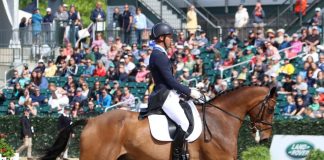 A new worldwide Eventing Risk Management Policy and Action Plan aimed at reducing cross-country horse falls was launched at the third annual FEI Safety meeting in Malmö, Sweden, in January. Based on a six-year statistical study of the sport, the Action Plan will be a functional and reliable system that will be used to monitor risk factors in Eventing, and to streamline international data and ideas to further understand the root causes of falls.
A new worldwide Eventing Risk Management Policy and Action Plan aimed at reducing cross-country horse falls was launched at the third annual FEI Safety meeting in Malmö, Sweden, in January. Based on a six-year statistical study of the sport, the Action Plan will be a functional and reliable system that will be used to monitor risk factors in Eventing, and to streamline international data and ideas to further understand the root causes of falls.
“Eventing is and will remain a risk sport. Our duty is to manage that risk,” explains Giuseppe Della Chiesa (ITA), the new chairman of the FEI Eventing Committee and the FEI Eventing Risk Management Advisor.
“Our major goal was to have a professional system to monitor and manage the risk in the sport and we now have that. This is not an emotional reaction, it’s a structure that provides a systematic approach to managing the risks involved in our sport. There will still be accidents, but we can use this system to better manage the risk and keep it within acceptable and accepted levels.”
Alex McLin, FEI Secretary General, concludes: “The Eventing Risk Management Policy and Action Plan is a major step towards ensuring that our horses and riders are not exposed to unnecessary risk in what is inherently a risk sport. In the past there has been a tendency just to count the accidents, but we need to be more proactive and count all the near-misses too. It’s all part of a cultural shift in the mindset of the sport. Education is key.”
The Action Plan includes:
- Statistical database, to include medical and veterinary data on falls
- A standardized template to achieve consistency in the collection of international data (this will be produced twice a year)
- Compulsory appointment of a National Safety Officer (NSO) by all countries organizing international Eventing fixtures to collate statistics and gather information for the FEI in the event of a serious accident
- FEI guidelines on cross-country course design aimed at minimizing risk
- Continuing work on frangible pins and deformable structures for cross-country fences
- Education of everyone involved in the sport of eventing – riders, officials and course designers; risk management will become an integral part of all national seminars
- Increased focus and education about the definition of dangerous riding
Twenty-two nations were represented at the NSOs’ seminar in Malmö, where delegates demonstrated the greatly heightened awareness of risk management shown over the last two years and also the continually evolving nature of Eventing.
Steps taken include trials with and the patenting of deformable devices in Sweden, Britain, Canada, Netherlands and Italy; initiatives by the German and Czech Republic National Federations to teach riders safer falling techniques; emphasis on style in competitions in Canada and Germany; rider licensing, exams and rule changes in France; twice yearly medical examinations in Poland and a fitness badge in Germany, plus several other national projects.
Also read – Weighing the Risks of Three-Day Eventing
Canada’s National Safety Officer Peter Gray commented: “The forum has exceeded my expectations and it will make my job easier. The presentations from each country were really useful – it’s a great opportunity to see how the sport is developing worldwide and to share problems and ideas.”






Good idea.
Sounds good. Some of those cross-country accidents are devastating.
Thanks for the good article.
I’m glad something is being done because the sport eventing needed some safety help.